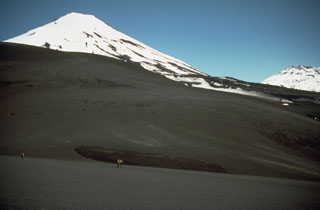Report on Lonquimay (Chile) — June 1989
Scientific Event Alert Network Bulletin, vol. 14, no. 6 (June 1989)
Managing Editor: Lindsay McClelland.
Lonquimay (Chile) Strong fluorine emission; one person and many animals killed
Please cite this report as:
Global Volcanism Program, 1989. Report on Lonquimay (Chile) (McClelland, L., ed.). Scientific Event Alert Network Bulletin, 14:6. Smithsonian Institution. https://doi.org/10.5479/si.GVP.SEAN198906-357100
Lonquimay
Chile
38.379°S, 71.586°W; summit elev. 2832 m
All times are local (unless otherwise noted)
The eruption was continuing as of late June. Explosive activity remained relatively weak (VEI 1) through much of May, with occasional more violent pulses (VEI 2) as on 1-3 and 16-25 May. Hugo Moreno flew over the area on 30 May. Strong WNW winds carried the plume directly over Lonquimay village (~20 km ESE of Navidad Crater; figure 12). The lava flow continued to advance very slowly at the front in the Lolco River valley (~9.5 km from the crater) and more vigorously at the Laguna Verde front (~4 km from the crater). Lava volume was estimated at 160 x 106 m3.
 |
Figure 12. Approximate ashfall thicknesses in the Lonquimay area, as of mid-May 1989, courtesy of O. González-Ferrán. The lava flow is shown in black. |
As of mid-June, hundreds of cattle and horses had died of osteofluorosis caused by 300-400 ppm fluorine on grass in an 80,000 hectare (800 km2) area. Some dogs have also recently died after suffering from nervous, renal, digestive, and breathing problems. Concentration of very fine ash has at times been at levels 10 times those considered safe for breathing. Mid-June medical checks of 260 people revealed neurological damage with associated reflex loss in 45 adults and children.
A report (quoted in the 24 June El Mercurio) from Maximino Beltrán, Regional Secretary of Health, to the national Subsecretary of Health, detailed numerous neurological and blood chemistry abnormalities discovered in varying proportions of area residents. An autopsy on a 64-year-old woodcutter, exposed to ashfall for more than 8 hours daily, revealed evidence of acute hemorrhagic colitis and massive bilateral lung hemorrhaging, plus central nervous system lesions. Similar lesions (plus lung, liver, and heart problems) were seen in seven dogs (one sick and six outwardly healthy) studied in the eruption area. The report recommended prompt evacuation of the most affected people, the 800 inhabitants of the Bernardo Nanco area, and the evacuation or relocation of ~3,800 persons judged moderately affected, in the town of Lonquimay. Evacuations had apparently begun by early July.
Geological Summary. Lonquimay is a small, flat-topped, symmetrical stratovolcano of late-Pleistocene to dominantly Holocene age immediately SE of Tolguaca volcano. A glacier fills its summit crater and flows down the S flank. It is dominantly andesitic, but basalt and dacite are also found. The prominent NE-SW Cordón Fissural Oriental fissure zone cuts across the entire volcano. A series of NE-flank vents and scoria cones were built along an E-W fissure, some of which have been the source of voluminous lava flows, including those during 1887-90 and 1988-90, that extended out to 10 km.
Information Contacts: H. Moreno, Univ de Chile; O. González-Ferrán, Univ de Chile; Pedro Riffo, Univ de la Frontera; El Mercurio, Santiago.

